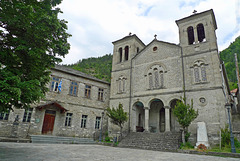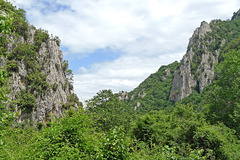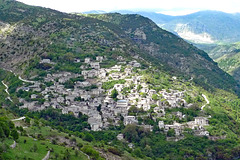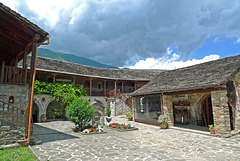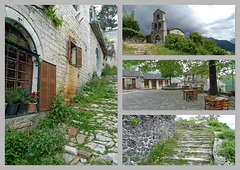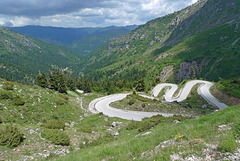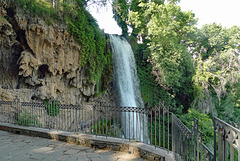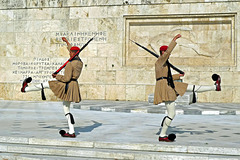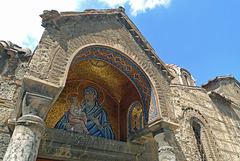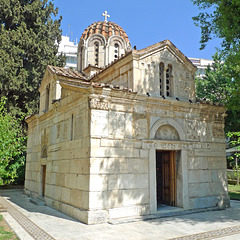Jaap van 't Veen's photos
Nederland - Maastricht, Sint-Servaasbasiliek
| |
|
|
|
The Romanesque Sint-Servaasbasiliek (Basilica of Saint Servatius) is built on Saint Servatius - an Armenian missionary who died in Maasticht in the year of 384 -gravesite. It is likely that the current building is the 4th iteration of churches on this site. The first church was a small memorial chapel, which was replaced by a larger church. Next, a pilgrim church was built. Finally, the current church was built between the 11th and 12th centuries.
The Sint-Servaasbasiliek is considered being the oldest still standing church in the Netherlands. The large, triple-nave transept basilica was built largely in Romanesque style, using millstone grit and marl. The church building serves as a parish church of the Roman Catholic St. Servatius parish and deanery church of Maastricht.
Since 1985, the church has held the title of minor basilica. The church, the cloisters, and the treasure room are open to the public and can be visited.
Nederland - Nunhem, Sint-Servaaskapel
| |
|
|
|
The Sint-Servaaskapel (Saint Servatius Chapel) is a pigrimage chapel. The cahpel is dedicated to Saint Servatius and is located on a ‘hill’ (the Servaasberg) on the edge of the Leudal.
A Servaas chapel at this site was first mentioned in 1744, when it was shown on a map. The chapel was restored in 1877, but the current, neo-Gothic chapel was built in 1891. The chapel was consecrated in 1892. The latest restoration took place in 1994.
Behind the chapel is the Saint Servatius well that is said to have been dug by the saint himself in order to use the well, which is 15 meters above the level of the stream, to baptize the first local Christians.
Greece - Patmos, Monastery of Saint John the Theol…
| |
|
|
|
In 1088 in Patmos, St. Christodoulos the Latrinos (a gifted and educated monk) was granted funds by the Byzantine Emperor Alexios I Komnenos, to establish a monastery in honor of Saint John the Theologian. In 1091, Christodoulos began the construction of the monastery over the ruins of a 4th-century basilica, also dedicated to Saint John.
The Monastery of Saint John the Theologian, built on top of Chora, dominates the whole island and looks like a Byzantine castle. It is surrounded by an irregular rectangular defensive enclosure, dating from the late 11th century until the 17th. Among other buildings the katholikon and cells have been preserved since the Byzantine period. The monastery’s walls are over 15 meters high, its length from north to south is 53 meters and from east to west 70 meters.
The library of the monastery and the rich collection of relics is considered really famous, the most important examples of which can be admired in the sacristy.
In 1999, the Monastery of Saint John the Theologian was declared a “World Heritage Monument” by UNESCO, along with the Holy Cave of the Apocalypse.
As my wife's ancestors lived on Patmos in the 18th century, we have visited the island a couple of times. Since we have an original letter from one of the abbots, we also visited the monastery, hoping for additional information. Unfortunately, nothing was found there at such short notice.
Greece - Patmos
| |
|
|
|
Patmos is inhabited since 3000 BC, but the identity of its first inhabitants is still unknown. Finds have excavated various buildings, cemeteries, fortresses, and evidence of an ancient acropolis, testifying the existence of a densely populated area in the past.
Patmos declined when the Romans conquered it. It was used as a place of exile for convicts. This is how Apostle John came to Patmos. He conveyed the inhabitants to Christianity and wrote the Book of Revelation, the Apocalypse. Patmos then became a place of worshipping and pilgrimage and actually.
During the Byzantine times, the inhabitants of Patmos built a Grand Royal Basilica in honor of Saint John. During the Arab raids from the 6th to the 9th century the basilica was destroyed. In 1101 the construction of the Monastery of Saint John the Theologian started. The fame of the monastery grew and a settlement started to expend around it. During the end of the 12th century, the island of Patmos was transformed into a large commercial center.
In 1522, the Turks came to the island; after a while, they left the island, which they just forced to pay some taxes. When the Turkish-Venetian Wars ended, tranquillity returned to Patmos and the island flourished, becoming once again an important commercial center. Massive fortifications were built around the monastery as a protection from the pirates. In 1655, Patmos was governed by the monks and prospered again. Its growth stopped in 1659, when the Venetians, conquered and destroyed the island of Patmos. With shipping, commerce and the efforts of the inhabitants, Patmos regained its lost nobility, glamour and prosperity.
The Russians conquered the island in 1770, after the Turkish-Venetian War. The Greek Revolution started in 1821 and managed to gain the independence of Greece in 1832. The treaty signed in London did not include the islands of the Dodecanese as part of the newly built Greek State and therefore fell again under Turkish occupation.
The Italians occupied all the islands of the Dodecanese in 1912, with of course Patmos, and remained there until 1943, when the Germans took over the island. In 1945, the Germans left and the island of Patmos remained autonomous until 1948 when it joined the rest of independent Greece with the rest of the Dodecanese Islands.
In 1981, Greece declared Patmos a “Sacred Island'', and in 1999 UNESCO included The Historic Centre (Chora) with the Monastery of Saint John the Theologian and the Cave of the Apocalypse in its World Heritage Site List. Patmos is also part of the COESIMA network, as one of the seven most important pilgrimage sites in Europe.
Greece - Nauplion, Agia Moni
| |
|
|
|
The nunnery of Agia Moni is located a couple of kilometers outside the town of Nafplion. The katholikon (= main church) is dating back to the middle of the 12th century. It is one of the most important churches of the middle Byzantine period in Greece. According to its foundation inscription the church was built with donations of the bishop of Argos and Nafplion, who had constructed it in the year of 1149.
The church is mainly of architectural interest as the murals and decorations have not survived. Apart from the church, the monastery complex consists of small chapels and housing and living quarters for the nuns, who still life here. The church is dedicated to Zoodochos (= “Source of life”). Just outside the nunnery one can find the monastic spring, which is famous for its water.
Greece - Monodendri, stone forest
| |
|
|
|
The stone forest nearby Monodendri is one of the most remarkablke places in Greece. Layers of natural rock formations shaped like trees at an altitude of 1.500 meters. Geomorphs that resulted from the disintregation and erosion of limestone in an alpine environment, located in a normal forest of oaks and maples. It took thousands and thousands of years to cause this erosion and disintregation of the slabs. Nowadays these towering limestone formations create a real natural ‘artwork’.
Greece - Samos, Pythagorion
| |
|
|
|
Pythagorion is one the most picturesque villages on the island of Samos. It is named after the famous philosopher and scientist Pythagoras. Pythagorion has a beautiful port where many beautiful old sailing ships, fishing boats and ferries to other islands moor. This harbour is maybe one of the oldest ports in the Mediterranean sea.
The town with its traditional old houses with red-tiled roofs is built amphitheatrically around the bay, where the ancient town of the island was found during excavations..
Greece - Pyrsogianni, Church of St George
| |
|
|
|
The new Church of St George was built in 1903-1905, after the old church - dating back to the year of 1712 -with the same name was demolished. Although rather ‘young’ the church has a beautiful interior with remarkable pillars, some chandeliers and a woodcarved iconostase.
The Church of St. George was built according to the standards of the Cathedral of Athens, with voluntary work of craftsmen of the village, while the basic cost of the construction was covered by the contributions of people coming from Pyrsogianni from all over the world.
Greece - Pogoniskos/Boútsikon
| |
|
|
|
On our car journey from Molyvdoskepastos - close to the Albanian border - to Konitsa, we found ourselves on a very narrow road through a pristine stretch of nature. It was impossible to turn around and we had to drive on to the very tiny hamlet of Pogoniskos with just a couple of inhabitants. That had the advantage of taking us past a countless number of 'carpets' of wild flowers in all sorts of colours and shapes (see PiPs). The valley was enclosed by rugged cliffs.
Greece - Syrrako
| |
|
|
|
Syrrako is a beautiful and picturesque village, which impresses with its grey stone houses that are perched on a steep slope of Mount Peristeri on an altitude of 1.200 meters. The ‘fairytale’village – located in the heart of the Tzoumerka region - is declared to be a traditional settlement. The village offers stone houses with slate roofs, cobbled alleys, churches, watermills, stone fountains, which are creations of renowed craftsmen.
Syrrako was built by Greek Vlach speakers in the 15th century. Around the year of 1480 the village along with other villages in the area, went under the Ottoman domination but managed to secure a privileged tax treatment and some kind of autonomy. Syrrako and neighboutring Kalarrytes were the only villages of Epirus that took part in the Greek Revolution from the first years. During that period, the village was looted and burnt down by the Turks and the inhabitants abandoned it, trying to save their lives. They returned in the year 1825 and rebuilt Syrrako.
Greece - Monastery of Panagia Molyvdoskepastos
| |
|
|
|
The history of the Monastery of Molyvdoskepastos goes back in the Byzantine era and was originally built in the 7th century. It is one of the oldest monasteries in Greece. Its founder was the Byzantine emperor Constantine IV Pogonatos. The monastery was renovated in the 14th century by Andronikos Komnenos Doukas Palaiologos. The monastery owes its name from the lead roof it once had: i>molivdoskepasti means “with a roof of lead”. The lead was stolen by Turks to make bullets and was then replaced by slates.
The katholikon (main church) belongs to a complex architectural style and was built in three phases. The original church with three vaults and a dome, was the first to built (11th and 12th century). The middle cross vaulted section was added at the end of the 13th century and in the beginning of the 14th century. Finally, an open narthex was added in the year of 1521 by the inhabitants of a nearby village. The interior of the church is decorated with splendid wall and ceiling paintings of the 14th and 16th centuries. The iconostasis is carved, probably dating back to the 15th century with remarkable icons.
After 1913 the monastery remained without monks, its properties were encroached and its holy artifacts and relics were stolen. In 1943, when the area was bombarded by the Nazis, it was almost razed to the ground. In 1988 the monastery was manned once more by the present day brotherhood.
From the outside the monastery looks (a little bit) like a fortress, due to its walls and gatehouse (PiP5). It is located about 20 km from the town of Konitsa, some hundred meters away from the Aoos River and the border with Albania.
Greece - Kalarrytes
| |
|
|
|
Kalarrytes (Kalarrites/Kalarites) is one of the most beautiful villages of Greece. Its houses are built according to the traditional Epirotic architecture. The village boasts beautiful stone bridges, cobbled roads, stone houses with traditional schist roofs, old drinking fountains and watermills.
The village - like neighbouring Syrrako - was built in the 14th and 15th centuries by Vlach pastors. The Vlach inhabitants, having secured special privileges and the protection of the Valide sultan. Thanks to their sharp business acumen, helped the village grow through the trade of not only agricultural products, but also the particular goods in which they specialized. The silversmiths of Kalarrytes were known for quality craftsmanship. The family Voulgaris is very well known; one of them moved to Roma in the 1880s and opened a store that would become the famous brand Bulgari.
Kalarrytes - surrounded by the imposing mountains of Tzermouka - lies at an elevation of 1200 meters and is sometimes called the ‘Eagles’ Nest of Epirus’.
Greece - Tzoumerka
| |
|
|
|
Tzoumerka - also called Athamanika - is a mountainous region in northwestern Greece, between Ioannina, Arta and Meteora. Its highest point in Tzoumerka – part of the Pindus mountains - is the mountain Katafidi with 2.393 meters.zoumerka. The region is not very well known, yet offering an “earthly paradise”, picturesque villages, extraordinary monasteries, surrounded by gorges, rivers and steep mountains.
Tzoumerka has a low population density with just some smaller villages. Forests dominate the low-lying areas of the mountain; grasslands, shrubs and barren rocks the higher elevations.
The name Tzoumerka seems to be of Vlach origin, as “tzoum” in the language of Vlachs means the “steep peak”.
We took a drive through the most rugged and remote part of Tzermouka: Metsovo - Syrrako. This was one of the most challenging and exciting road trips we have ever driven. Imagine a narrow road - barely wide as a car - full of small and even large boulders, sometimes a partially eroded road surface (PiP4). That road winds steeply through the landscape with many hairpin bends. To make matters worse, we also faced fog for much of the drive. After the hamlet of Chaliki, the road improved to reach an altitude of almost 2,000 metres - sometimes with snow on the roadside. With a countless number of curves, we finally reached Syrrako. With that, this Greek adventure came to an end.
Greece - Edessa, waterfalls
| |
|
|
|
The Edessa waterfalls - Greece’s largest waterfalls - are quite exceptional. Centuries ago people made a bassin for their water supply, but in the 14th century the river changed it course ((perhaps after a geologic or weather phenomenon) creating first one waterfall but later on several other small waterfalls.
The most impressive waterfall - called Karanos - has a height of 70 meters. The smaller twinfall is called Lamda. It is possible to walk behind the big Karanos waterfall where one has a perfect view with a water curtain (PiP 4).
Greece - Athens, changing the guard
| |
|
|
|
Greek guards or “Evzones” - also known as “Tsoliades” - are members of the Presidential Guard found outside the Hellenic Parliament. They have become synonymous with the city of Athens and were originally founded in 1868 as a regiment of the Greek army. It is a high honour for a soldier to be selected to join the “Evzones”.
They guard the grave of the Unknown Soldier that represents the common memory of all unknown soldiers killed at war. The changing of the Greek guards occurs every day at the top of the hour.
The “Evzones” are required to stand guard mute and expressionless for 60 minutes at a time, and are harshly punished if they succumb to the tantalizing efforts of tourists from all over the world to break their concentration.
Greece - Athens, Church of Panagia Kapnikarea
| |
|
|
|
The Church of Panagia Kapnikarea (Εκκλησία της Παναγίας Καπνικαρέας) is one of the oldest churches in Athens. It is located on the heart of the cty along an important shopping street. In 1834, after Greece had regained its independence and Athens, as the new capital, was in the midst of rebuilding, town planners had resolved to either demolish or relocate the church to ensure a thoroughfare for horse and carriages. The church had caught the eye of King Louis of Bavaria (father of the newly appointed King Otto of Greece) as an important landmark and together with the Metropolitan Bishop of Athens, ensured the street was designed with the church in place.
The church of Panagia Kapnikarea is a small Byzantine church dating from the 11th century. It was erected on an old church of the 5th century, itself built on a Greek temple. The church now belongs to the University of Athens and is also d "Church of the Sacred University".
The church’s name is linked with the family name “Kapnikares” and refers to the official charged with collecting tax on tobacco during the Byzantine period. It was formerly known as “Kamoucharea” from the word “kamoucha”, which means fabrics that are interwoven with gold, referencing the many textile workshops in the area.
Greece - Athens, Anafiotika
| |
|
|
|
The history of the charming neighbourhood of Anafiotika goes back to the mid-1800s. Greece needed workers to transform the new capital. Carpenters and masons from the island of Anafi (and other areas) came and took over this rocky terrain. They took advantage of the Ottoman law that stated a property belonged to you if you could build it between sunset and sunrise.
Anafiotika is a gem island-like oasis. Perched on the back of the Acropolis, the Anafiotika neighbourhood offers narrow, winding, shady streets with flowers and cats and views of the city. The narrow streets are lines streets with small white-washed osland-style houses. It looks like a village lost in time, filled with bougainvillaea, jasmine and other plants.
Greece - Athens, Little Metropolis Church
| |
|
|
|
The Little Metropolis (Μικρή Μητρόπολη), formally the Church of St. Eleutherios (Άγιος Ελευθέριος) is a Byzantine church located next to the large Metropolitan Cathedral of Athens ("Great Metropolis") .
The Little Metropolis Church - measuring just seven by eleven meters - is one of the smallest churches in Athens, but is also considered one of the oldest and most beautiful. It was built on an old temple - most probably in the early 13th century - and was mainly used for intercessions by pregnant women. Before the Great Metropolis Church was built, it was even a bishop's church.
Jump to top
- ipernity © 2007-2024
- Help & Contact
|
Club news
|
About ipernity
|
History |
ipernity Club & Prices |
Guide of good conduct
Donate | Group guidelines | Privacy policy | Terms of use | Statutes | In memoria -
Facebook
Twitter








